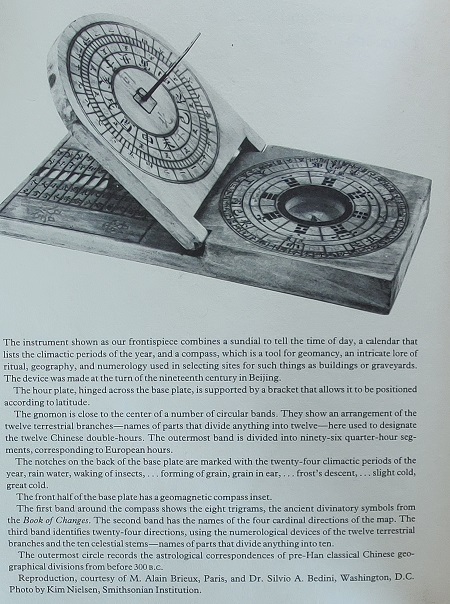If numbers can be considered the letters of a universal alphabet, then the perfect arrangement of numbers that can describe the formulas of mathematics correspond to heavenly statements of mathematical fact. (This represents the only pure truth of our universe).
When
humankind discovers these mathematical equations and can apply them to daily
life, society reaps the benefits of evolution and prosperity. It would be a
natural progression for symbols to be born, symbols that are directly related
to the advancement of humankind. The
integration of these math symbols with art and architecture can then tell the
story of civilization. The Chinese magic
square is one such symbol.
This
paper is dedicated to the basic elements of numerology, i.e. the symbolism of
numbers based on the Chinese magic square of three, otherwise known as the Luo
Shu.
The
Luo Shu represents the ideal model of time and space: time as in the numbers of
the calendar and space as in the Pythagorean Theorem, the most important
mathematical relationship to ancient civilization. Hence, the Luo Shu was the basic model the
early Chinese determined as their concept of the world and was incorporated
into art, architecture, city design, royal tomb design, and served as an
important correspondence to a select group of Chinese pictograms.
As
time unfolded, different cultures would adopt the model of the Luo Shu with
usage of its perfect symmetrical template to be found in Roman mosaics, early
Christian art and architecture, Islamic pottery, tiles and textiles, and Italian
Renaissance art.
The
magic square is represented by the quincunx design, or quincuncial composition,
which is based on the arrangements of numbers within the magic square and the
powerful math that lies within its manifestation. The model of the magic square became a motif
repetitive in art and architecture which represented the implementation of math
to establish order on earth.
Christianity
incorporated magic square symbolism in its early church design, illuminated
manuscripts, textiles and more. The
walls, windows, pavements, and mosaics of the church were adorned with this
motif. In fact, the cross and square
ground plan, also known as the nine-bay church ground plan also known as the
quincunx ground plan, was the most popular church design in Medieval times.
Why the Magic Square?
Table 1. The first magic square and the corresponding formula; in the example of an order 3 magic square, X = 3 and Y = 5. A magic square is defined as an arrangement of numbers in a square such that the sum of any row, column, or major diagonal will yield a singular result, in this case 15. Pythagorean triads highlighted in green. (Note: it is necessary to use Y as a means to express the fraction
(X2 + 1) ÷ 2 for an easier visual processing of the formula).
The formula above allows the generation of higher order magic squares in the Luo Shu format as long as X is odd and greater than one.
To understand the wisdom
that the Luo Shu offers, one must consider that the Luo Shu represents a “set
of magic squares” based on a common formula that can be expanded to include
higher order magic squares; the Luo Shu is not limited to just the 3x3 magic
square. A “set” of magic squares
traditionally used in alchemy would include the odd and even magic squares up
to order nine; this author considers the Luo Shu set of magic squares to
include only odd magic squares up to the order twenty-seven. Examination of the math of the higher order
magic squares will give insight to the various mathematical properties
associated with magic squares in the Luo Shu format.
The fraction (X2 + 1) ÷ 2 will be
represented by Y and will always equal the center number of the
corresponding magic square. X and
Y will always be the odd components of a Pythagorean triad, (X)(Y)
will equal the magic constant, and X2Y will equal the sum
total of all the numbers in the square, or ∑X2.
Table 2. The first three magic squares of the Luo Shu demonstrating the Pythagorean Theorem in the form of Pythagorean triplets of numbers (in green) in the shape of a gnomon or right angle.
The first significant
feature of the Luo Shu is the Pythagorean triad of numbers in the shape of the
carpenter’s square or gnomon, an important symbol that is closely associated
with the Luo Shu as it also represents time and space as well as applied
mathematics (see table 2).
The second outstanding feature of magic squares in the Luo Shu format is the cross of odd numbers that run through the horizontal and vertical axis with a center point of reference.
The early Chinese believed these squares were a communication from Heaven because of the wisdom contained within. As these squares exhibit the Pythagorean Theorem, a center, and a cross of odd numbers that separates the square into four quadrants, the “luo shu” squares became a perfect model to represent Heaven and earth in microcosm, to be used in art and architecture while at the same time communicate a wisdom of mathematics that would remain hidden, known only to the intelligentsia. This explanation can help to understand why this pattern shows up across a diversity of cultures, beginning with the early Chinese and continuing thru the Renaissance era. This model, or symbol, of numerology would therefore be transformed into an artistic composition of motifs beautifying tiles, pavements, mosaics, books, and textiles to mark structures and objects of religious or political import.
effective date of registration: January 30, 2025
Registration decision date: April 25, 2025
Author: Robert Dickter























